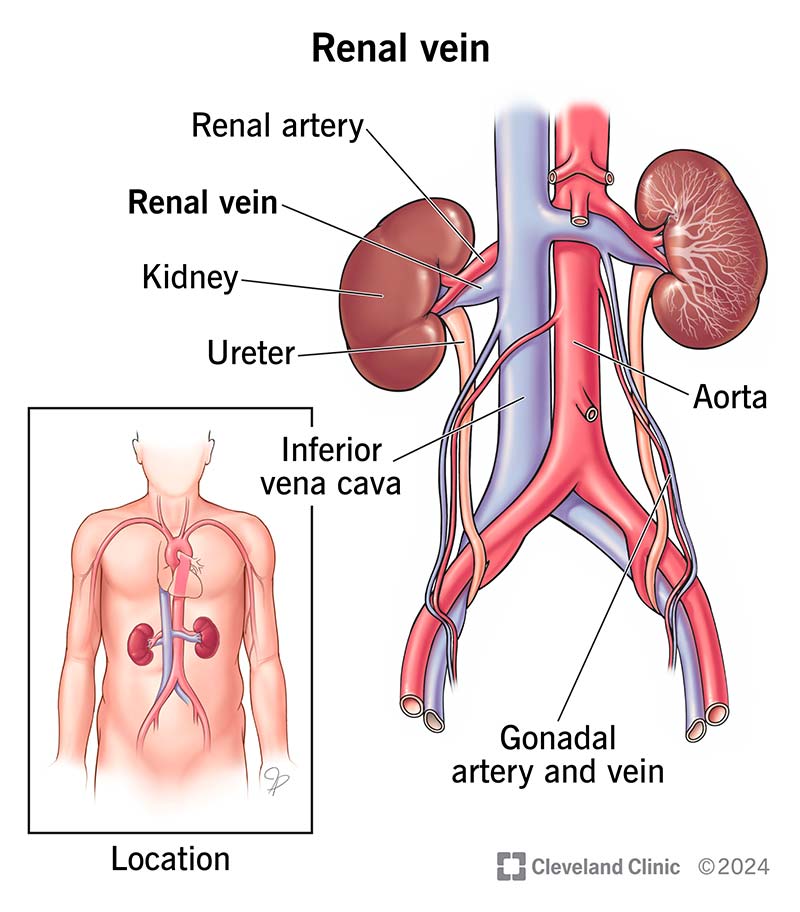Your renal veins carry blood from your kidneys to your heart. Both of your kidneys have a renal vein. But they aren’t symmetrical, which means they aren’t the same on both sides — your right renal vein is shorter than your left. Some conditions may cause blood clots in your renal veins or squeeze your veins, which affects blood flow.
Advertisement
Cleveland Clinic is a non-profit academic medical center. Advertising on our site helps support our mission. We do not endorse non-Cleveland Clinic products or services. Policy

The renal vein is a blood vessel that carries blood from your kidney to your heart. “Renal” is another word for kidney.
Advertisement
Cleveland Clinic is a non-profit academic medical center. Advertising on our site helps support our mission. We do not endorse non-Cleveland Clinic products or services. Policy
Most people have two kidneys, and each one has its own renal vein.
Your renal arteries and renal veins are part of your circulatory system. Your circulatory system carries (circulates) blood throughout your body. Your blood:
Your renal arteries carry blood with high levels of oxygen (oxygenated blood) from your heart to your kidneys. After your kidneys filter toxins and organic residues from your oxygen-rich blood, your renal veins carry the deoxygenated and filtered blood from your kidneys to your heart.
Your kidneys sit in the back of your abdomen (belly), below your ribcage and above your waist.
Your left renal vein is on the left side of your body, behind your splenic vein and pancreas. Your left renal vein is farther away from your inferior vena cava, so it’s longer — about 2 to 4 inches (6 to 10 centimeters).
Your right renal vein is on the right side of your body, behind the top of your small intestine (duodenum). Your right renal vein is about ¾ of an inch to 1.5 inches (2 to 4 centimeters) in length.
Because your left renal vein is longer and farther away from your inferior vena cava, it receives blood from other organs in your body, including your:
Advertisement
Your right renal vein only receives blood from your right kidney.
Your kidneys filter (clean) waste products from your blood. They also utilize oxygen and glucose (sugar) in your blood as energy sources to filter it. Then, your renal veins send the filtered (clean) and deoxygenated blood into your inferior vena cava. Your inferior vena cava is a large vein that carries deoxygenated blood from the lower part of your body to your heart.
Common conditions that affect your renal veins include:
Renal vein blockage may cause:
A healthcare provider may order the following imaging tests to help check the health of your renal veins:
A provider may also order a pee test (urinalysis) to check if you have high protein levels (proteinuria) or blood in your pee. The presence of either may indicate kidney damage.
It’s a good idea to get a yearly physical exam to check your risk of developing blood clots. To help improve the health of your renal veins, they may recommend:
Your renal veins play an important role in your circulatory system, draining blood from your kidneys and other organ systems. It can be difficult to know if something specifically affects your renal veins. However, regular physical exams can help healthcare providers look for signs of conditions that affect your renal veins. Providers are also your best source of information for keeping your kidneys and renal veins healthy. And they can tell you what to expect if you have a problem.
Advertisement
Last reviewed on 09/27/2024.
Learn more about the Health Library and our editorial process.